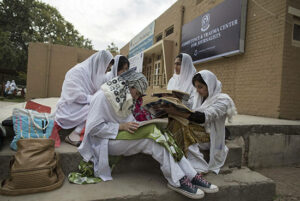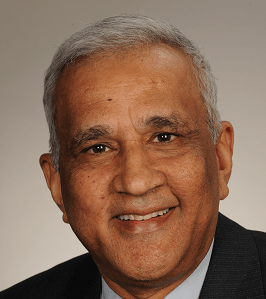At the outset, one needs to analyse the system of higher education in Pakistan in a historical perspective. There were only a few universities in Pakistan in the 1950s and ‘60s, but since their heads were educated in the UK, they were quite efficient. Education was not a priority in the 1970s and was neglected by the government; in the 1980s it was highly politicised with political, religious and ethnically oriented student organisations fighting pitched battles on campuses, resulting in a ban on student unions. On the other hand, in 1983 General Zia’s regime awarded a charter to the Aga Khan University, the first one in the private sector, followed by another charter given to the Lahore University of Management Sciences (LUMS). Since both institutions were well endowed and their sponsors did not have profit motives, therefore, high calibre and well-paid faculty members, mostly consisting of highly educated Pakistanis who were working abroad were appointed at these two universities.

Thus, on the one hand, public sector universities continued to deteriorate and on the other hand, in the 1990s more universities in the private sector were granted charters by the provincial assemblies, without the approval of the Federal University Grants Commission. There was a mushroom growth of universities, with no regard to criteria relating to faculty requirements and educational standards. Unfortunately, no attention was paid by our policy makers to provide quality education to the growing population of youth.
One example I often cite is that when I was doing my post-graduate studies in USA in the 1970s, there were hundreds of students from Pakistani universities enrolled in Masters’ and PhD degree programmes at Ivy League and other top universities in America, after completing their undergraduate studies. Unfortunately, their numbers have gradually declined and one would rarely find such students doing PhD at US universities. Thus, while I worked at John Hopkins University and Princeton University, and later at the London School of Economics in the 1990s and 2000s, I found only a handful of post-graduate students who had completed under-graduate studies in Pakistan. Today, most Pakistani students at US universities are children of Pakistani immigrants, or are from elite schools in Pakistan or those who were awarded scholarships under the Fulbright programmes, mostly graduates of LUMS. The reasons are simple; the high standards of education which were pursued by the academics of the 1950s and ‘60s who spearheaded various departments at the public sector universities till the 1970s are no longer there. Instead, with the passage of time, all the top university positions are given to people who have had no exposure to higher education abroad and are not familiar with international academic standards, depriving students of quality education. Thus today, Pakistan’s ranking in higher education is one of the worst among Asian countries. One expected that the void would be filled by the newly chartered universities in the private sector. However, most concentrate in offering BBA, MBA or MBBS degrees, while liberal arts education (in social and natural sciences) has no priority.

Besides, the role of universities is not only to award degrees but to provide an intellectual environment to well-trained academics that could stimulate the younger generation towards intellectual growth. Instead, with the exception of a couple of universities in the private sector, most recruit faculty members only to deliver lectures, with little provision for interaction between faculty and students. Since most faculty members are teaching part-time, (and a great majority of them are not even regular teachers, but business executives) and paid on an hourly basis, they have no time for any intellectual discourse with students outside the classroom, nor do they have any interest or knowledge about conducting research.
With this background, the Higher Education Commission (HEC) was established in 2002 under the chairmanship of a renowned scientist, Dr. Atta Ur Rehman, to regulate higher education in the country and keep a check on the quality of education imparted in both public and private sector universities. Although the budget for higher education was substantially enhanced and an emphasis placed on research by faculty members, the HEC looked the other way when most government colleges were upgraded to universities and public sector universities were established even at district headquarters, without the availability of appropriate faculty members. Besides, there was mushroom growth of privately owned universities and degree awarding institutes in every corner of the provincial capitals and in other cities. While, faculty for public sector universities were mainly drawn from the PhDs awarded by local universities, the private universities became the dumping ground for retired professors from the public sector universities.
In the short history of the HEC, it has had four chairmen. The last three had an uneasy relationship with the higher ups and all four were shown the door for some reason or the other. The reasons cited for their removal are different. The founding Chairman, due to his close relationship with General Musharraf, was able to accomplish much. However, with the change of the government in 2007, he was forced to resign. The second Chairman was very close to the then party in power, but lost favour when he declined to accept the fake degrees of MNAs and Senators. The third Chairman, being close to the then Education and Planning Minister, did whatever he was asked to do, but was unable to continue due to questions raised about his academic credibility. The fourth Chairman was blamed for inefficiency and unceremoniously removed from office without being charge sheeted, through an ordinance that shortened his tenure from four to two years. However, he claims that he was removed due to his refusal to toe the line of the higher ups. It appears that the continuation of chairmanship of the HEC is primarily at the whims of the government in power. Either there was a problem with the recruitment process or successive governments did not want to give a free hand to the HEC.
The major accomplishments of the HEC during the tenure of the first Chairman had to do with the establishment of a large number of universities and enhancing the number of locally produced PhDs. The subsequent chairmen tried to follow suit but during their tenures, the HEC’s budget was substantially reduced. However, the mushroom growth of universities both in the public and the private sector continued, along with the production of local PhDs. Thus, the quality of education has been substantially compromised, particularly at the post-graduate level. For example, the number of PhD degrees granted since the inception of the HEC has grown exponentially, without any checks on quality.
Being a social scientist, during the past ten years I have examined about a couple dozen theses for the award of PhD degrees in different disciplines from various public sector universities in Pakistan and can testify that most are far below international standards. Besides, I am also aware about the award of PhD degrees, particularly in Management Sciences by one of the largest universities in the country to bank managers, businessmen, serving bureaucrats, journalists and even serving employees of the HEC. Some HEC employees got PhD degrees, sitting in Islamabad, perhaps without taking a single course beyond their previous degrees, per the HEC requirements. It is also a fact that several PhD degrees have been awarded on the basis of theses written by someone else, and at times plagiarised.
Indeed the top priority of the HEC should have been overhauling the whole PhD system, including not allowing those who received their Bachelors, MS and/or MPhil degrees from a Department at a particular University to enrol in a PhD programme at the same place. Thus, over the entire period of their higher education those who have been awarded PhDs have had no exposure outside the walls of their university (or even department), which is a perfect example of educational inbreeding. One of the former Executive Directors of the HEC confided in me, saying that “since the fate of a PhD student is tied to one supervisor, he/she becomes a personal servant of the PhD supervisor.” Interestingly, after obtaining a PhD, a faculty member becomes a PhD supervisor, thus the whole cycle is repeated. Unfortunately, most locally qualified faculty members at universities do not go through the process of post doctorate, whereby, a person has to complete two to three years of research work after obtaining a PhD. This is widely practiced in several countries, including in India, but is not a requirement in Pakistan.
I had several discussions on this issue with the previous HEC Chairman, who was inclined to change the PhD system, whereby PhD students’ research would be supervised by a committee of three professors, as is the case in the USA and Canada. Furthermore, my suggestion was that students should be discouraged to enrol in a PhD programme from the place that they received their undergraduate and Masters’ degrees. However, these proposals were rejected by HEC staff and apparently the powerful academic associations at universities were also opposed to any changes.
Higher education in Pakistan needs a substantial overhaul, particularly in the areas of research and faculty development. Once a person is appointed as a lecturer he/she gets enrolled in the PhD programme in the same Department and after getting a PhD degree in three or four years, does not face any hurdles to promotion as an assistant professor. For promotion to associate professor, a faculty member has to have three years of post-PhD experience and publish ten papers in an HEC recognised journal, irrespective of the quality of publications and without assessment of teaching ability by students. The same exercise is repeated for promotion as a full professor, with a few years of additional experience and five more publications. While serving on the selection and promotion boards of a few universities, I have noticed that a faculty member rarely publishes a paper as a single author, and in most cases there are three or four authors, each claiming credit for the same paper

Another anomaly is that after completing their PhD, over the rest of his/her academic life span, a faculty member is not expected to attend any formal training in research or teaching methodology. Nor is there provision of sabbatical leave to pursue research at universities abroad. Although most faculty members end up serving as Department Chairmen, and several get an opportunity to serve as Registrars, Deans or even Vice Chancellors, they never attend a course in administrative skills, as is required for promotion to the next rank among civil servants and in the armed forces, where it is mandatory to attend courses before being considered for promotion.
If one were to evaluate the performance of the HEC during the past 18 years as an institution, it may get an average grade of C or 2 out of 4 points. As far as the performance of universities is concerned, in terms of quantity, even after the establishment of a total of about 200 universities in Pakistan, according to UNESCO, the tertiary enrolment ratio (those in age group 17-23) in Pakistan is one of the worst. For example, during 1990 and 2014, it increased from 3 to 10 percent in Pakistan, as against an increase from 4 to 14 percent in Bangladesh; from 6 to 34 percent in India; from 7 to 30 percent in Malaysia; from 15 to 65 percent in Iran and from 13 to 79 percent in Turkey. Similarly, in the worldwide ranking of universities, based on the contributions by their faculty in research and innovation, it is no wonder that none of the Pakistani universities is ranked below 500, and only a few are ranked between 500 and 1,000.
It is therefore high time, that the performance of the HEC is evaluated and its role redefined, before appointing a new chairman. Besides, a proper ranking system of universities should be devised by a third party. Otherwise, the future of higher education in Pakistan will remain bleak.

The writer is a Distinguished Senior Fellow at the School of Public Policy, George Mason University, United States.



